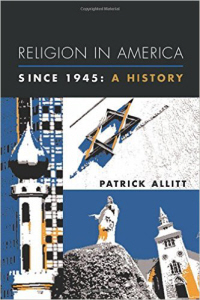Book Review: Religion in America Since 1945: A History
 Religion in America since 1945: A History, by Patrick Allitt, copyright 2005. ISBN 978-0231121552, 384 pages, four stars.
Religion in America since 1945: A History, by Patrick Allitt, copyright 2005. ISBN 978-0231121552, 384 pages, four stars.
Several years ago, as I tried to understand America’s religious history, I stumbled across Religion in America since 1945: A History by Patrick Allitt. Few books, I realized, cover this specialized subject so effectively.
Religion in America paints a picture of a vast theological shift – a tectonic reshaping of American religious society in a remarkably short time. In 1945, Protestantism and Roman Catholicism were battling for majority. Within 60 years, both would diminish, fragment, and descend to infighting.
America entered the Cold War as a so-called ‘Christian,’ ‘God-honoring’ nation struggling against the ‘Atheistic,’ ‘Man-centered’ philosophy of Communism. Yet simultaneously, it was morphing into a patch of heretical, cultic, and anti-Christian weeds. Protestantism, meanwhile, continued to fragment into liberals, evangelicals, and fundamentalists. Christianity was tainted (however unfairly) with charges of intolerance and bias as some groups advocated racial segregation.
Even as the old orthodoxy crumbled under repeated secular and liberal attacks, few champions of faith stepped into the fray. Rather, many fundamentalists and evangelicals compromised the gospel, scandalized religion, or adopted heresies.
Finally – years into the conflict and long overdue – a few bright spots began to emerge, such as Francis Chaffer’s conservative response to liberalism. Yet overall, these bright spots remained few and far between, and as the book ends, new and even more overwhelming attacks from secularism and liberalism appear on the horizon, bearing down on the crumbling and diffident conservative Protestants.
I found Religion in America to be an excellent summary of religious history. Far from naming denominations and listing religious leaders, it traces themes that are intimately woven into the religious, political, and national history of our nation. The book seemed overall even-handed in its approach. While I picked up a few liberal biases, I can’t say for certain that any passage made that clear.
Many lessons emerged from this book. For one, we do not have a population that knew and rejected Biblical truth. No, we live in an age when – for many people – even the most basic Christian beliefs are unknown. Much of the foundation must be built from the ground up.
It was fascinating and horrifying – fascinating that a nation could decline so quickly, and horrifying that our religious foundation crumbled so fast. In the end, the American church is left in the same position as the early church in Rome – in a heterodox, pluralistic nation. We need the gospel more than ever.




Comments are closed, but trackbacks and pingbacks are open.